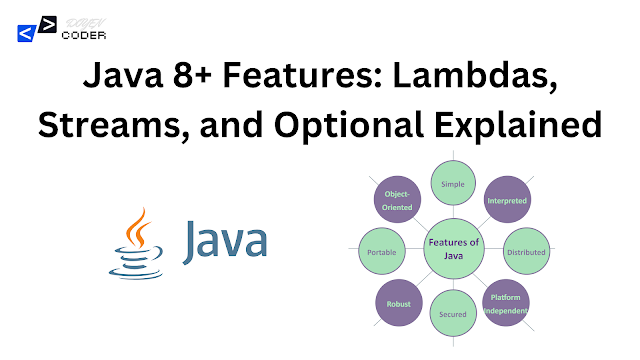Java 8+ Features: Lambdas, Streams, and Optional Explained
1. Introduction
Java 8 marked a significant milestone in the evolution of the language, introducing powerful features like Lambda expressions, the Stream API, and the Optional class. These features bring functional programming elements to Java, making it easier to write clean, concise, and maintainable code. This article will dive into each of these features, providing detailed explanations and practical examples.
2. Lambda Expressions
Lambda expressions are one of the most revolutionary features introduced in Java 8. They allow us to treat functionality as a method argument or pass code as data, enabling a more functional programming style. Essentially, a lambda expression provides a concise way to represent anonymous functions.
The syntax for lambda expressions is simple: `(parameters) -> expression` or `(parameters) -> {statements}`. Lambda expressions are primarily used in functional interfaces, which are interfaces that contain a single abstract method (SAM).
Example of a Lambda Expression
import java.util.Arrays;
public class LambdaExample {
public static void main(String[] args) {
List names = Arrays.asList("Alice", "Bob", "Charlie", "David");
// Sorting using Lambda Expression
names.sort((a, b) -> a.compareTo(b));
// Printing sorted list
names.forEach(System.out::println);
}
} In the example above, the lambda expression `(a, b) -> a.compareTo(b)` is passed to the `sort()` method, replacing the need to create an anonymous `Comparator` class.
Key Benefits of Lambda Expressions
1. **Conciseness**: Lambda expressions reduce the amount of boilerplate code required for simple operations, such as passing functionality into methods.
2. **Readability**: Code becomes more readable as it focuses on the operation rather than implementation details.
3. **Enhanced Functional Programming**: Java 8 allows a functional programming approach by using lambdas in conjunction with streams and other Java APIs.
3. Stream API
The Stream API is another core feature introduced in Java 8, designed to facilitate functional-style operations on collections of data. A `Stream` represents a sequence of elements supporting sequential and parallel aggregate operations. It allows you to perform operations like map, filter, and reduce on collections in a declarative way.
The main benefit of streams is that they allow processing of collections in a lazy and optimized manner, which makes the code concise and improves performance, especially with large datasets.
Example of Stream Operations
import java.util.Arrays;import java.util.stream.Collectors;
public class StreamExample {
public static void main(String[] args) {
List numbers = Arrays.asList(1, 2, 3, 4, 5, 6, 7, 8, 9, 10);
// Using Stream API to filter even numbers and double them
List result = numbers.stream()
.filter(n -> n % 2 == 0)
.map(n -> n * 2)
.collect(Collectors.toList());
System.out.println(result); // Output: [4, 8, 12, 16, 20]
}
}
Common Stream Operations
1. **Filter**: The `filter()` method is used to select elements based on a condition (predicate).
2. **Map**: The `map()` method transforms each element of the stream into another form (e.g., applying a function).
3. **Collect**: The `collect()` method is used to accumulate the elements into a collection, list, or any other data structure.
4. **Reduce**: The `reduce()` method performs a reduction on the elements of the stream, such as summing or concatenating elements.
Parallel Streams
Java 8 also provides support for parallel processing with streams. You can easily switch between sequential and parallel processing using the `parallelStream()` method, which processes elements concurrently, leveraging multiple cores for enhanced performance.
List numbers = Arrays.asList(1, 2, 3, 4, 5, 6, 7, 8, 9, 10); .forEach(n -> System.out.println(n + " processed by " + Thread.currentThread().getName()));
4. Optional Class
One of the most common issues in Java is dealing with `null` references, leading to the infamous `NullPointerException`. Java 8 introduced the `Optional` class to mitigate this issue. `Optional` is a container object that may or may not contain a non-null value. It provides methods to safely handle the presence or absence of a value, reducing the need for null checks.
Example of Using Optional
import java.util.Optional;
public class OptionalExample {
public static void main(String[] args) {
Optional optionalValue = Optional.ofNullable(getValue());
// Using ifPresent() to safely operate on the value if it exists
optionalValue.ifPresent(val -> System.out.println("Value: " + val));
// Using orElse() to provide a default value if the Optional is empty
String result = optionalValue.orElse("Default Value");
System.out.println(result);
}
private static String getValue() {
return null; // Simulating a method that might return null
}
}
Common Methods in Optional
1. **isPresent()**: Returns true if the value is present, otherwise false.
2. **ifPresent()**: Executes a specified action if the value is present.
3. **orElse()**: Returns the contained value if present, otherwise returns the default value.
4. **orElseThrow()**: Returns the value if present, otherwise throws an exception.
5. Conclusion
Java 8 introduced several powerful features that significantly improve the developer experience. Lambda expressions enable more concise and readable code, while the Stream API facilitates functional-style operations on collections. The Optional class provides a more elegant way of handling `null` values, reducing the risk of `NullPointerException`. These features, along with others introduced in Java 8+, make the language more robust, expressive, and suitable for modern application development.
Summary of Content:
- Introduction: Provides an overview of Java 8 features that transformed Java coding styles.
- Lambda Expressions: Explains how lambdas can simplify code by removing the need for anonymous inner classes and makes code more concise.
- Streams API: Describes how the Streams API enables functional-style processing of data with filtering, mapping, and reducing.
- Optional Class: Shows how
Optionalhelps avoidNullPointerExceptionand manage optional values safely.
- Conclusion: Summarizes the benefits of these Java 8 features for more expressive and safer code.









0 Comments